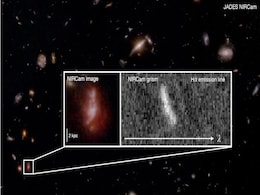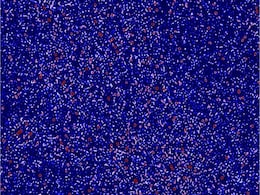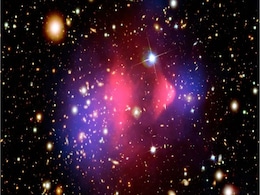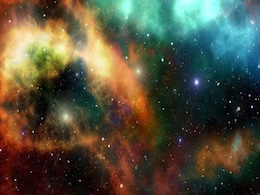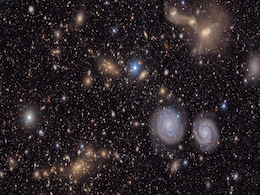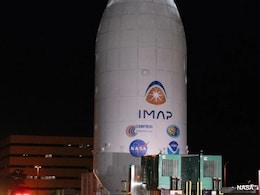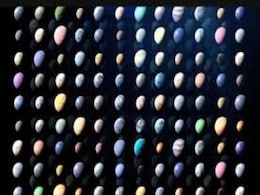Cosmic Study
- All
- News
- Videos
-

Dark Matter and Dark Energy Might Not Exist After All, New Study Suggests
- Saturday November 8, 2025
- Written by Gadgets 360 Staff
A new theory suggests dark matter and dark energy may not exist. Physicist Rajendra Gupta’s model proposes that the universe’s forces weaken over time, naturally explaining cosmic expansion and galactic motion without unseen matter or energy.
-
 www.gadgets360.com
www.gadgets360.com
-

Scientists Recreate Cosmic ‘Fireballs’ in Lab to Solve Mystery of Missing Gamma Rays
- Wednesday November 5, 2025
- Written by Gadgets 360 Staff
Scientists recreated cosmic plasma beams at CERN to study why certain gamma rays vanish in space. The results showed the beams remain stable, suggesting ancient intergalactic magnetic fields, not beam collapse, hide the signals. The discovery provides new insight into cosmic jets and the universe’s earliest magnetic traces.
-
 www.gadgets360.com
www.gadgets360.com
-

Dark Matter May Behave Like Ordinary Matter Under Gravity, New Study Finds
- Tuesday November 4, 2025
- Written by Gadgets 360 Staff
A new study shows dark matter falls into cosmic gravity wells much like ordinary matter, narrowing one of astronomy’s biggest mysteries. Researchers say any unknown force acting on dark matter must be very weak, though future missions could detect smaller effects. The findings bring scientists closer to understanding how the universe’s unseen m...
-
 www.gadgets360.com
www.gadgets360.com
-

Keio University Team Measures Ancient Cosmic Temperature, Confirming Big Bang Prediction
- Tuesday November 4, 2025
- Written by Gadgets 360 Staff
Using ALMA, Keio University scientists measured a 5.13 K cosmic background temperature from 7 billion years ago—matching Big Bang predictions of universal cooling. This precise reading, based on quasar absorption data, is the most accurate at that epoch and offers strong confirmation of how the Universe’s temperature decreases over time.
-
 www.gadgets360.com
www.gadgets360.com
-

James Webb Telescope Finds Early Universe Galaxies Were More Chaotic Than We Thought
- Thursday October 23, 2025
- Written by Gadgets 360 Staff
The James Webb Space Telescope has revealed that galaxies in the early universe were far more chaotic and unstable than once believed. A new study shows that gas turbulence and intense star formation disrupted young galaxies, reshaping scientists’ understanding of how galaxies evolved into the structured systems seen today.
-
 www.gadgets360.com
www.gadgets360.com
-

Scientists Create Most Detailed Radio Map of Early Universe Using MWA
- Saturday October 18, 2025
- Written by Gadgets 360 Staff
Scientists using the Murchison Widefield Array in Australia analyzed nine years of radio data to study the elusive 21-cm hydrogen signal from the universe’s dark ages. Their findings suggest early black holes and stars had already heated cosmic gas, marking the first observational evidence of this warming phase.
-
 www.gadgets360.com
www.gadgets360.com
-

Dark Matter Might Leave A Faint Colour Mark In Light, Say Scientists
- Thursday October 16, 2025
- Written by Gadgets 360 Staff
Dark matter, though invisible, might subtly alter the colour of light passing through it, according to a new University of York study. Researchers propose that weak particle interactions could create faint red or blue tints, offering a new path for future telescopes to detect dark matter indirectly.
-
 www.gadgets360.com
www.gadgets360.com
-

Pulsar Observations Could Reveal Gravitational Wave Interference From Black Holes
- Wednesday October 15, 2025
- Written by Gadgets 360 Staff
A new study proposes detecting gravitational-wave “beats” using pulsar timing. Researchers from Hirosaki University suggest that interference between waves from supermassive black hole binaries could appear as periodic variations in pulsar signals. The method may help distinguish individual sources from a diffuse gravitational-wave background i...
-
 www.gadgets360.com
www.gadgets360.com
-

Physicists Predict When Life On Earth Will End In A Reverse Big Bang
- Thursday October 9, 2025
- Science | Edited by Nikhil Pandey
A new study predicts the Universe will stop expanding in 11 billion years and collapse in a "Big Crunch" around 20 billion years from now.
-
 www.ndtv.com
www.ndtv.com
-

Rubin Observatory Adopts New AI Algorithm to Enhance Cosmic Imaging
- Tuesday September 30, 2025
- Written by Gadgets 360 Staff
Scientists have developed ImageMM, an algorithm tested on Hawaii’s Subaru Telescope and soon to be used at the Rubin Observatory. The system reduces atmospheric blur, producing sharper images for studying galaxies and dark matter. Researchers believe the technique could make ground-based astronomy nearly as precise as space telescopes
-
 www.gadgets360.com
www.gadgets360.com
-

Deep-Sea Beryllium-10 Hints at Supernova Debris Reaching Earth 10 Million Years Ago
- Tuesday September 30, 2025
- Written by Gadgets 360 Staff
A new study has uncovered deep-sea evidence suggesting Earth may have been struck by debris from a nearby exploding star 10 million years ago. Scientists found unusually high levels of Beryllium-10 in Pacific crusts, consistent with a supernova origin. The findings could transform understanding of cosmic influences on Earth’s history, though terr...
-
 www.gadgets360.com
www.gadgets360.com
-

James Webb Telescope Unveils Hidden Star-Forming Regions in Sagittarius B2
- Wednesday October 1, 2025
- Written by Gadgets 360 Staff
New JWST observations reveal the hidden star-forming activity inside Sagittarius B2, the Milky Way’s largest molecular cloud. By seeing through dense dust, astronomers can study how stars form efficiently in extreme environments. These findings help explain not only Sgr B2 but also broader mechanisms shaping galaxies.
-
 www.gadgets360.com
www.gadgets360.com
-

What Is Heliosphere? NASA's New Mission To Study Sun's Protective Bubble
- Thursday September 25, 2025
- Science | Edited by NDTV News Desk
NASA launched the Interstellar Mapping and Acceleration Probe (IMAP) spacecraft from Kennedy Space Center in Florida on Wednesday, September 24.
-
 www.ndtv.com
www.ndtv.com
-

NASA Confirms Discovery of 6,000 Exoplanets Beyond Our Solar System
- Sunday September 21, 2025
- Written by Gadgets 360 Staff
NASA has confirmed 6,000 exoplanets beyond our solar system, highlighting three decades of accelerating discovery. From scorching hot Jupiters to worlds with jewel-like clouds, the catalog reflects cosmic diversity. Future missions aim to identify true Earth analogs and investigate signs of life across distant planetary systems.
-
 www.gadgets360.com
www.gadgets360.com
-

Dark Matter and Dark Energy Might Not Exist After All, New Study Suggests
- Saturday November 8, 2025
- Written by Gadgets 360 Staff
A new theory suggests dark matter and dark energy may not exist. Physicist Rajendra Gupta’s model proposes that the universe’s forces weaken over time, naturally explaining cosmic expansion and galactic motion without unseen matter or energy.
-
 www.gadgets360.com
www.gadgets360.com
-

Scientists Recreate Cosmic ‘Fireballs’ in Lab to Solve Mystery of Missing Gamma Rays
- Wednesday November 5, 2025
- Written by Gadgets 360 Staff
Scientists recreated cosmic plasma beams at CERN to study why certain gamma rays vanish in space. The results showed the beams remain stable, suggesting ancient intergalactic magnetic fields, not beam collapse, hide the signals. The discovery provides new insight into cosmic jets and the universe’s earliest magnetic traces.
-
 www.gadgets360.com
www.gadgets360.com
-

Dark Matter May Behave Like Ordinary Matter Under Gravity, New Study Finds
- Tuesday November 4, 2025
- Written by Gadgets 360 Staff
A new study shows dark matter falls into cosmic gravity wells much like ordinary matter, narrowing one of astronomy’s biggest mysteries. Researchers say any unknown force acting on dark matter must be very weak, though future missions could detect smaller effects. The findings bring scientists closer to understanding how the universe’s unseen m...
-
 www.gadgets360.com
www.gadgets360.com
-

Keio University Team Measures Ancient Cosmic Temperature, Confirming Big Bang Prediction
- Tuesday November 4, 2025
- Written by Gadgets 360 Staff
Using ALMA, Keio University scientists measured a 5.13 K cosmic background temperature from 7 billion years ago—matching Big Bang predictions of universal cooling. This precise reading, based on quasar absorption data, is the most accurate at that epoch and offers strong confirmation of how the Universe’s temperature decreases over time.
-
 www.gadgets360.com
www.gadgets360.com
-

James Webb Telescope Finds Early Universe Galaxies Were More Chaotic Than We Thought
- Thursday October 23, 2025
- Written by Gadgets 360 Staff
The James Webb Space Telescope has revealed that galaxies in the early universe were far more chaotic and unstable than once believed. A new study shows that gas turbulence and intense star formation disrupted young galaxies, reshaping scientists’ understanding of how galaxies evolved into the structured systems seen today.
-
 www.gadgets360.com
www.gadgets360.com
-

Scientists Create Most Detailed Radio Map of Early Universe Using MWA
- Saturday October 18, 2025
- Written by Gadgets 360 Staff
Scientists using the Murchison Widefield Array in Australia analyzed nine years of radio data to study the elusive 21-cm hydrogen signal from the universe’s dark ages. Their findings suggest early black holes and stars had already heated cosmic gas, marking the first observational evidence of this warming phase.
-
 www.gadgets360.com
www.gadgets360.com
-

Dark Matter Might Leave A Faint Colour Mark In Light, Say Scientists
- Thursday October 16, 2025
- Written by Gadgets 360 Staff
Dark matter, though invisible, might subtly alter the colour of light passing through it, according to a new University of York study. Researchers propose that weak particle interactions could create faint red or blue tints, offering a new path for future telescopes to detect dark matter indirectly.
-
 www.gadgets360.com
www.gadgets360.com
-

Pulsar Observations Could Reveal Gravitational Wave Interference From Black Holes
- Wednesday October 15, 2025
- Written by Gadgets 360 Staff
A new study proposes detecting gravitational-wave “beats” using pulsar timing. Researchers from Hirosaki University suggest that interference between waves from supermassive black hole binaries could appear as periodic variations in pulsar signals. The method may help distinguish individual sources from a diffuse gravitational-wave background i...
-
 www.gadgets360.com
www.gadgets360.com
-

Physicists Predict When Life On Earth Will End In A Reverse Big Bang
- Thursday October 9, 2025
- Science | Edited by Nikhil Pandey
A new study predicts the Universe will stop expanding in 11 billion years and collapse in a "Big Crunch" around 20 billion years from now.
-
 www.ndtv.com
www.ndtv.com
-

Rubin Observatory Adopts New AI Algorithm to Enhance Cosmic Imaging
- Tuesday September 30, 2025
- Written by Gadgets 360 Staff
Scientists have developed ImageMM, an algorithm tested on Hawaii’s Subaru Telescope and soon to be used at the Rubin Observatory. The system reduces atmospheric blur, producing sharper images for studying galaxies and dark matter. Researchers believe the technique could make ground-based astronomy nearly as precise as space telescopes
-
 www.gadgets360.com
www.gadgets360.com
-

Deep-Sea Beryllium-10 Hints at Supernova Debris Reaching Earth 10 Million Years Ago
- Tuesday September 30, 2025
- Written by Gadgets 360 Staff
A new study has uncovered deep-sea evidence suggesting Earth may have been struck by debris from a nearby exploding star 10 million years ago. Scientists found unusually high levels of Beryllium-10 in Pacific crusts, consistent with a supernova origin. The findings could transform understanding of cosmic influences on Earth’s history, though terr...
-
 www.gadgets360.com
www.gadgets360.com
-

James Webb Telescope Unveils Hidden Star-Forming Regions in Sagittarius B2
- Wednesday October 1, 2025
- Written by Gadgets 360 Staff
New JWST observations reveal the hidden star-forming activity inside Sagittarius B2, the Milky Way’s largest molecular cloud. By seeing through dense dust, astronomers can study how stars form efficiently in extreme environments. These findings help explain not only Sgr B2 but also broader mechanisms shaping galaxies.
-
 www.gadgets360.com
www.gadgets360.com
-

What Is Heliosphere? NASA's New Mission To Study Sun's Protective Bubble
- Thursday September 25, 2025
- Science | Edited by NDTV News Desk
NASA launched the Interstellar Mapping and Acceleration Probe (IMAP) spacecraft from Kennedy Space Center in Florida on Wednesday, September 24.
-
 www.ndtv.com
www.ndtv.com
-

NASA Confirms Discovery of 6,000 Exoplanets Beyond Our Solar System
- Sunday September 21, 2025
- Written by Gadgets 360 Staff
NASA has confirmed 6,000 exoplanets beyond our solar system, highlighting three decades of accelerating discovery. From scorching hot Jupiters to worlds with jewel-like clouds, the catalog reflects cosmic diversity. Future missions aim to identify true Earth analogs and investigate signs of life across distant planetary systems.
-
 www.gadgets360.com
www.gadgets360.com






